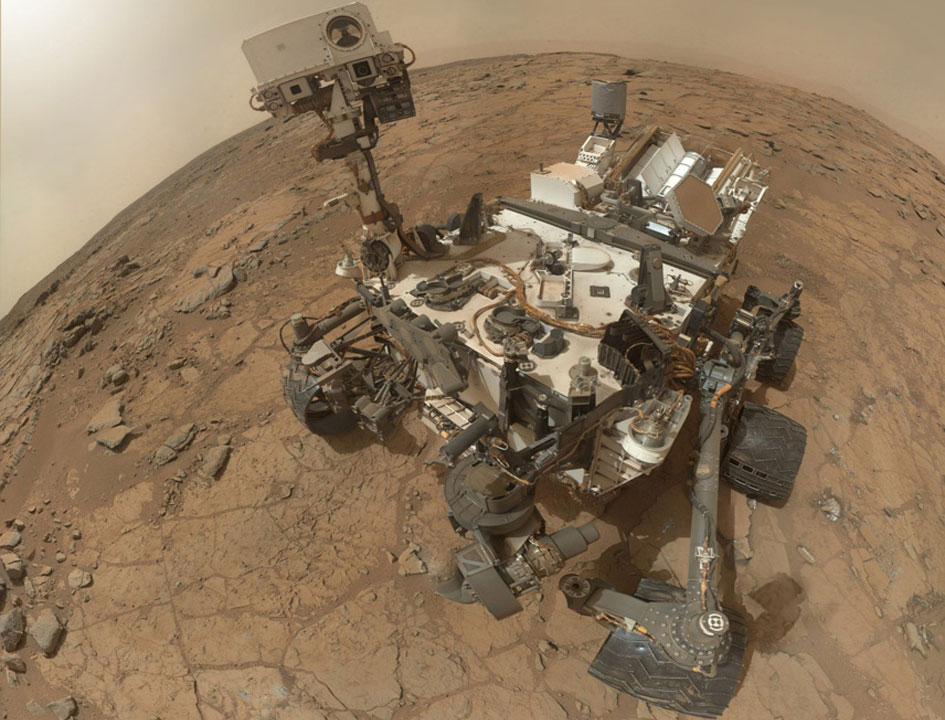CuriousMars: Drilling For Martian Secrets

Two powerful laboratories inside the Mars rover Curiosity are being readied to process the first powdered samples of subsurface Martian rock obtained by the rover’s drill during the most complex series of Curiosity operations since its Sky Crane landing last August.
But there may be questions about whether the rock characteristics found during an initial shallow “mini-drill” test late February 6 are suitable for deeper drilling and sample acquisition.
As part of the laboratory preparation process, the $70 million Goddard Space Flight Center Sample Analysis at Mars (SAM) instrument processed a “blank cell” this week to calibrate the instrument for its first analysis of powered rock coming as quickly as this weekend or early next week if the current target is found suitable.

Shallow test hole drilled by Curiosity late Feb. 6 shows gray tailings slung far from the drill bit especially to the left in this MAHLI image . The character of the talus and hole on Mars is being matched with rocks with similar compositions drilled on Earth with rover engineering hardware. Credit: NASA/JPL-Caltech/MSSS.
To further calibrate the system SAM has six calibration cups with carbonate and other carbon compounds with known properties available for heating to 1,562 deg. F (850 deg. C) for measurement of the gases given off.
The other internal instrument, the Ames Research Center CheMin chemistry and mineralogy instrument is being prepared to use its on board permanent calibration cells to crosscheck with sample results once the instrument reaches that point with the rock sample about to be introduced.
The first shallow drilling of a Martian rock appears to have been completed late Feb. 6, a major milestone toward soon drilling as deep as a 2.5 inch (6.3 cm.) for the first sample.

Rover drill’s percussion test divot was imaged by MAHLI. Note white calcium sulfate vein close by. The MAHLI camera was 4 inches (10 centimeters) off the ground and shows an area only about 3 inches (7.7 centimeters) wide. The length of the gray divot cut by the drill bit is about two-thirds of an inch (1.7 centimeters). Credit NASA/JPL-Caltech/MSSS.
Essential to the success of the $2.5 billion rover’s mission is a chain the chain of hundreds of software, mechanical and science events that are slowly and safely building to the successful drilling and analysis of powdered subsurface rock.
Drilling milestones were slowly being completed this week after an initial percussion test on Martian rock was aborted by a robotic arm software gremlin on Jan. 30, or Sol 174 for Curiosity. That test involving brief pounding by the chisel like drill bit was successful by Sol 176.
The pounding actions left an oval shaped divot creating what appear to be gray tailings in a somewhat soft rock. Curiosity engineers at the Jet Propulsion Laboratory, Pasadena Calif. pulled an all-nighter to clear the problem by the next day to prevent operations from falling more than one day behind.

Curiosity’s chiseling drill bit is 0.6 inch (1.6 centimeters) wide. This view merges three exposures taken by the ChemCam telescope at different focus settings. Credit: NASA/JPL-Caltech/LANL/CNES/IRAP/LPGNantes/CNRS.
This ‘drill-on-rock’ checkout used the brief hammering action of Curiosity’s drill without rotation for assurance that the percussion mechanism and associated control system are properly tuned for hitting a rock. The rover’s electronics enable a precise tuning of hammering force, applied to specific rock characteristics.
The “mini-drill” actual first drilling of a Martian rock appears in the rover’s raw imagery to have been at least partially completed by late Feb. 6 or Sol 180. As planned it only produced a small ring of tailings on the surface of the rock while penetrating just 0.78 in. (2 cm.). As planned this activity did not go deep enough to auger rock powder into the drill’s sample-gathering chamber.
“The purpose is to see whether the tailings are behaving the way we expect. Do they look like dry powder? That’s what we want to confirm,” said Daniel Limonadi, JPL’s lead systems engineer for Curiosity’s surface sampling and science system.

Science turret positions drill bit on Martian rock in first attempt for percussion test with no rotation on Sol 174. That test was delayed for 2 days, however, when rover software or circuitry detected what it thought was a robotic arm problem. Credit: NASA/JPL-Caltech/MSSS/Marco Di Lorenzo/www.KenKremer.com.
After a 12 hr. of analysis of the tailings and the rock’s suitability for drilling, the Jet Propulsion Laboratory Surface System Science (SSS) team could give a “Go” for drilling as early as Feb. 7-8 or a “No Go” if the mini-drill results raise questions. That recommendation will be presented to Curiosity Mission Management who will ultimately decided whether additional test and analysis is needed or whether the actually drilling is finally approved.
If the drilling is approved both the drill’s rotation and percussion capabilities will be set to bore up to a 2.5 inch (6.3 cm.) deep hole where powder will be obtained at the bottom.
A tiny pinch of subsurface rock powder will first be delivered for analysis to the rover’s internal CheMin chemistry and mineralogy lab that uses X-ray diffraction for analysis.

Black & white panorama of Curiosity working at the John Klein drilling area shows the alien Martian terrain of Yellowknife Bay on the floor of Gale Crater, with Mt. Sharp 6 mi. distant. Credit NASA/JPL-Caltech/MSSS/Marco Di Lorenzo/www.KenKremer.com.
Engineers want to know what kind of rock composition they are dealing with before placing a similar sample of it into the much more complex SAM instrument that will heat the powered rock to 1,832 deg. F (1,000 deg. C) to search for and characterize organic and inorganic molecules important to life.
In order to get to this point, the rover’s Canadian Alpha Particle X-ray Spectrometer (APXS) managed by the Canadian Space Agency and the University of Guelph, along with the U. S. / French ChemCam laser have been key to analyzing rock compositions to focus drilling operations in the small “John Klein” area of Yellowknife Bay.
Teamwork between the APXS and ChemCam instrument personnel, coupled with the Mars Hand Lens Imager (MAHLI) and Mastcam color high resolution imaging groups has been the critical to science and operations success in defining the composition of the site as the best drilling area.

Graphic depicts the joint U. S./French ChemCam laser firing on a rock to generate plasma revealing its composition. The laser has been fired about 12,000 times in the John Klein drilling area. Credit: LANL.
Roger C. Wiens, ChemCam principal investigator at Los Alamos National Laboratory in New Mexico says Curiosity’s mast mounted laser has been fired about 12,000 times to measure the abundance of chemical elements at very specific locations on rocks and soil in the John Klein area.
The U. S. and French teams share command of the laser system and begin a weekly switchover every Wednesday, a day when they jointly monitor surface operations for an efficient handoff, he said. That leads to the French and U. S. teams alternating full control of ChemCam science operations every Thursday, Wiens told CuriousMars.
Under this arrangement, command of laser firings will fully shift today from the ChemCam Operations Center at Los Alamos to a French Space Agency (CNES) Operations Center in Toulouse in southern France.
French Co-Investigator Sylvestre Maurice, who is with an astrophysics laboratory, the Centre d’Etude Spatiale des Rayonnements (CESR), leads the French ChemCam group.
The Los Alamos team will oversee operations jointly with the French next Wednesday, and then take back control for another week next Thursday.
The APXS has been doing similar work, but rather providing data on entire rocks rather than just points on those rocks.

Curiosity mast with ChemCam laser and telescope at top has medium and long range Mastcam color cameras directly under the laser box, while two over/under Navcams are on either side with a gold loop power cable on each side. Credit: NASA/JPL-Caltech/MSSS.
“We typically fire 30 shots or more into one pinpoint location. That is so we can get below the dust and into the rock and begin to see if there are any trends in the very top part of the rock. So that means the 12,000 shots collapse down into several hundred observation points,” said Wiens.
“We tend to shoot 4-9 different observation points on a given target. That is also so we can see whether there is heterogeneity or whether the sample is quite homogeneous. So we often do up to nine observation points on any one target,” he said.
“After we started to see sulfate veins in the John Klein area, we used these multiple observation points to march across a sulfate vein or to identify some small features better,” Wiens said.
The ChemCam team started to see strong sulfate data back in October well before the rover got to Yellowknife Bay. The rocks had the same water related compositions, but the veins of calcium sulfate were not yet visible. When the rover got into the bay, distinct veins and nodules of calcium sulfate were visible.
“It was exciting for us because we were able to see this with our composition data long before we could see it with our eyes on the images. That tells us the importance of this operating technique,” Wiens said.

The image shows a ChemCam’s telescope view as laser pulses strike a large white vein in a rock named “Rapitan”. A graph with the resulting analysis of its elemental composition underlies the picture. The spectral profile of Rapitan’s vein is shown in blue, while that of a basaltic calibration target of known composition is shown in black. These results suggest the veins are unlike typical basaltic material. They are depleted in silica and composed of a calcium-bearing mineral. Credit: NASA/JPL-Caltech/LANL/CNES/IRAP/LPGNantes/CNRS.








